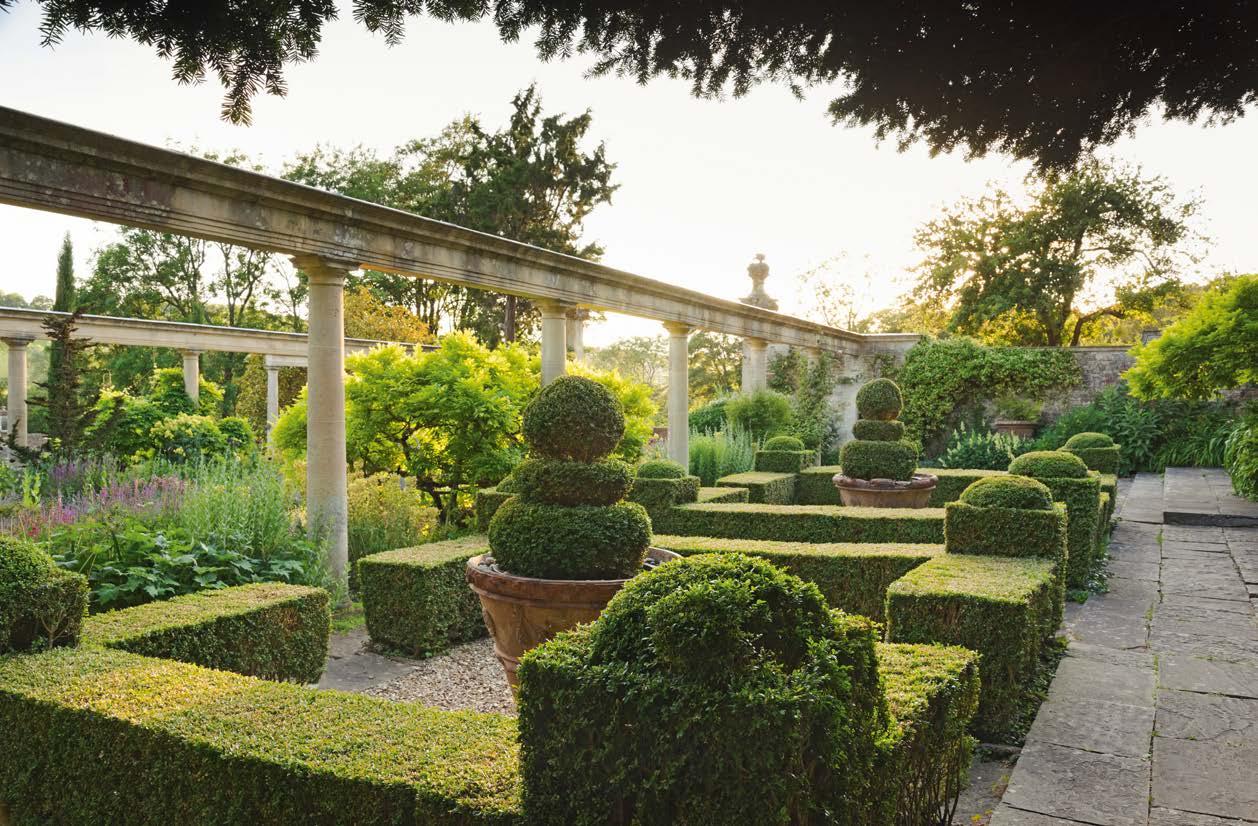
9 minute read
Iford Manor A labour of love for its
The Great Terrace at Iford Manor, its border full of opium poppies and catmint, with sculptural fragments from Peto’s travels.
LittleITALY
A labour of love for its Italophile creator, garden designer and architect Harold Peto, the garden at Iford Manor is a sunny slice of the Mediterranean hidden away in a Wiltshire valley


In 1898, the year before architect and garden designer Harold Peto bought Iford Manor near Bradford-on-Avon in Wiltshire, he undertook a journey around the world that included a ten-week stay in Japan. In his diary he writes: “Decidedly I will never undertake a long journey again... Far wiser to stay mostly at home and ‘cultivate your garden’… read about fardistant places and visit them in imagination… and appreciate the delights which are at hand…”
What finer place to ‘cultivate your garden’ than deep in a hidden English valley around a honey-coloured, 17th-century manor house with a handsome Palladian facade? Over two-and-a-half acres of mostly sloping ground, Peto created an intensely atmospheric ‘hanging garden’ su used with his love of Italy, despite its very English setting: the River Frome meandering through the valley bottom; lush woodland all around; wide pastoral views. Fittingly there are traces of Roman occupation on the surrounding hilltops.
Peto travelled to Europe many times during the 1880s and 1890s developing a deep appreciation of the Italian garden. Characterised by rigorous geometry, a limited plant palette, evergreen hedges, water features, terracotta pots and sculpture, these gardens informed Peto’s approach to his own garden and those he designed for others, such as Buscot Park in Oxfordshire and Ilnacullin on Garinish Island o the coast of south-west Ireland.
At Iford, Peto terraced his steep, south-facing hillside, linking levels with vertiginous flights of stone steps and building or adapting structures to display the treasures collected on his travels. He planted shrubs and trees redolent of the Mediterranean, including pencil cypresses, yew, box, juniper, rosemary and lavender, as well as plants deriving from the Far East, such as the wisteria and peonies he had so admired in Japan.
Peto died at Iford in 1933, leaving his garden and estate to his nephew, Michael, whose daughter sold it to Elizabeth Cartwright in 1964. Elizabeth, who has Italian ancestry, set about restoring and replanting the garden with advice from the landscape architect Lanning Roper. After marrying John Hignett in 1979, Elizabeth’s focus turned to the 900-acre estate, while the garden itself became mostly John’s domain: it’s largely because of their e orts that Iford has survived. Now both in their eighties, the Cartwright-Hignetts have handed the reins over to son William and his Top Palladian Iford wife Marianne. Manor overlooks the The Georgian garden tranquil River Frome. at Iford was renowned Left Steps colonised by for the beauty of its campanula and framed with bergenia and box woodland walks, meander upwards to although Peto fenced the Great Terrace. them o to keep out
This image Smartly clipped box topiary sits on the terrace just outside the Casita. Below The Great Terrace glows in the evening sun.




‘vermin’, seeing the wood as purely a backdrop. In the 18th century, the upper level of the garden, now the Great Terrace, was a simple, grassy walk where Thomas Gaisford, Dean of Christ Church, Oxford, would stroll while composing sermons. William wonders whether the placement of a statue of a philosopher on the terrace is a deliberate reference to the Dean and the use he made of it: “I think Peto was a master of allusion, placing his sculptures in a very knowing way,” he says. On the Conservatory Terrace where Peto sited statuary and carved reliefs of angels and bishops, there was once a chapel.
Peto employed stonemasons from nearby Westwood to create the crowning glory of the Great Terrace – an elegant limestone colonnade. At the west end of the terrace a semi-circular seat curves apse-like around a Byzantine wellhead and a Roman column topped by a stone lion; at its east end is an 18th-century octagonal Top A view of the Great gazebo. Displayed along Terrace as seen from the garden’s upper slopes. this ‘triumphal way’ is Middle The Japanese a parade of sculptures, garden has a completely which includes a pair of di erent atmosphere: 18th-century, German calm, shady and green. Bottom Classical statuary hounds, a French bust includes this piece, of a woman, and a The Dying Gladiator. bronze cast of Romulus

Wrought ironwork and an entrance flanked by a pair of Italian marble figures.


and Remus being suckled by a wolf. Wisteria spirals around every structure, dripping with racemes of scented purple flowers in May.
Behind the Great Terrace is the Casita, a loggia where pink marble columns from Verona frame a dancing nymph and a box parterre – a late 20th-century invention that replaces Peto’s original flowerbeds. In a corner of the yew hedge surrounding the parterre, a gate leads into the Japanese garden. Like going through the wardrobe to discover Narnia, the mood changes: sounds are mu ed, temperature drops, light is washed green.
“My father created the Japanese garden, finishing something that Peto had started but left incomplete,” says William. Location scouts for the recent film of Frances Hodgson Burnett’s classic children’s book The Secret Garden fell in love with Iford and its Japanese garden plays a significant part in the film. William and Marianne hope it will eventually introduce more people to the garden, although they are keen to emphasise the importance of protecting Iford’s air of tranquillity.
William and Marianne are well equipped to take Iford into its next phase: William, a linguistics graduate, is fluent in Above A fitting stone French and Spanish and sculpture for the experienced in retail (he Japanese Garden’s founded Iford Manor dappled green light, a pagoda sits among Teas); Marianne read shade-loving ferns economics at university such as asplenium. and has resumed her
Sun WORSHIPPERS
Heat-loving perennials and shrubs add a touch of the Mediterranean to Iford Manor’s borders

PHYGELIUS CAPENSIS
Cape figworts are super shrubs for pots. Protect in winter weather below -10°C.

PAPAVER SOMNIFERUM
Let opium poppies seed around for silken flowers in pink and purple hues.

OLEARIA MACRODONTA
Grey-green toothed leaves and daisy flowers on a shrub that hails from New Zealand.

LOBELIA TUPA
Felty grey-green leaves and eye-catching spikes of scarlet tubular blooms. Protect the crown with a winter mulch.

PENSTEMON ‘SOUR GRAPES’
Pale lilac-blue trumpets with white throats are held on upright, bushy stems.

SALVIA NEMOROSA
Choose cultivars of this sunloving salvia for flower spikes in shades of pink and purple from June to October.


career in finance after taking a break following the birth of son Horatio in 2018, cheerfully admitting that when she married William, she married Iford too. Recruiting an experienced and imaginative head gardener was a key part of their plan for Iford’s future and Troy Scott Smith took up the post in 2019 after seven years as head gardener at Sissinghurst Castle Garden in Kent. He knew Iford from his time at The Courts in nearby Holt, saying: “It was the valley I responded to more than the garden back then, the feel it has of being tucked away. The puzzles and challenges the garden presents are interesting, and I seem to like a project so it’s a good time to be here.”
Troy has drawn up a nine-year plan that includes replacing trees and shrubs that have “grown out of scale or become shabby”, eradicating ground elder from borders, establishing a vegetable garden to supply the new café and reopening the woodland walks. Twenty-five cypress trees recently arrived from Italy to replace the vertical planting that has been lost over time. A new senior gardener, Helen Braithwaite, who had previously worked at RHS Wisley, joined gardener Shane Open, who has been at Iford for years. Ten volunteers have also been
Top left A secluded lily pond with a 16th-century figure of a huntsman. Top right A flight of steps is lined with 18th-century vases from Richmond House and softened by erigeron and campanula. Above A cast of an ancient Roman sculpture depicting a wolf suckling Romulus and Remus. selected, many of whom are studying for RHS qualifications. Little is known of the herbaceous plants that Peto grew, although over the years 274 metal plant labels have been found, which do give some clues. “It’s important that the tone of the planting is consistent through the garden so we get the look and feel that Peto liked and I want to be strict in using plants from Mediterranean regions to achieve that,” explains Troy. “Scented flowers and foliage will be important; colour not so much.”
Above the entrance to the Cloister, completed in 1914, Peto inscribed a line from Tennyson’s poem ‘The Palace of Art’: “A haunt of ancient peace.” Though Iford will be a hub of activity over the next few years, this profoundly peaceful fragment of the Mediterranean, so artfully threaded through an English hillside, is in very safe hands.
Iford Manor, Bradford on Avon, Wiltshire BA15 2BA. It is intended that the garden will open for prebooked visits only from April through to September, Wednesday to Sunday and Bank Holiday Mondays, 11am to 4pm. Check online for the most up-to-date visitor information at ifordmanor.co.uk

Second NATURE

Having acquired a blank canvas at The Old Rectory on the Isle of Wight, Louise and Derek Ness have applied an organic approach to reinstate native species in the meadows and attract wildlife, while indulging their passion for roses








